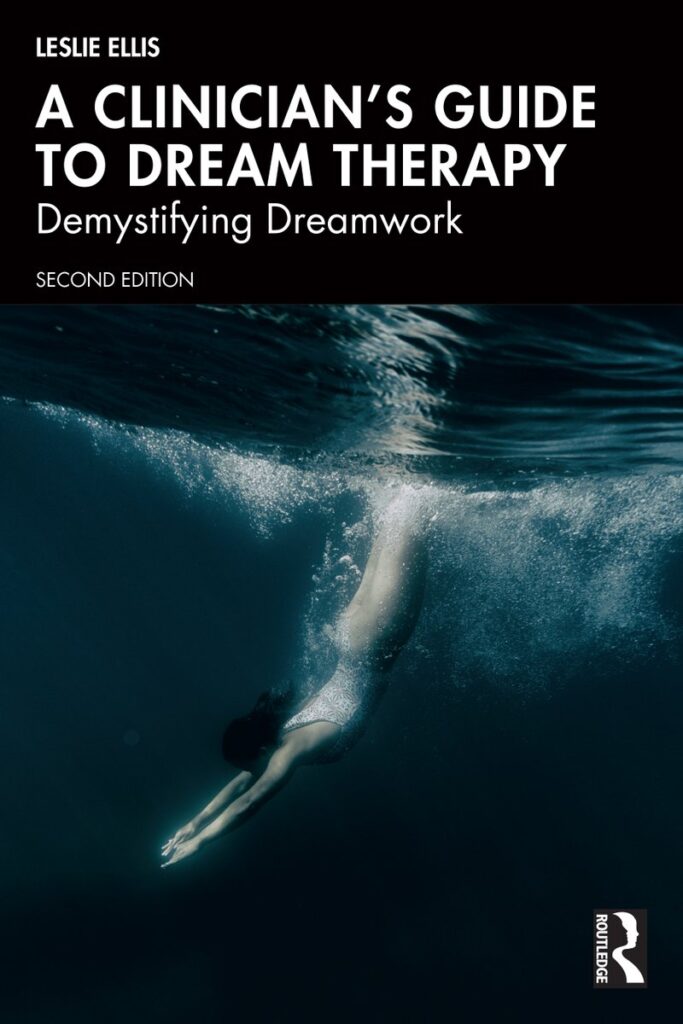The Book
A Clinician’s Guide to Dream Therapy- 2nd Edition
DEMYSTIFYING DREAMWORK
Grounded in research.
Expanded for real-world clinical work.
Trusted by therapists worldwide, this updated edition includes new insights on nightmares, detailed case examples, and practical tools to bring dreamwork into your practice with depth, sensitivity and confidence.
“Leslie Ellis is in my view the world’s best clinician and writer in the area of dream and nightmare treatment. She is scholarly and has an in-depth knowledge of brain-body interaction, but writes very accessibly, with great examples of how dreams — even the most horrific — can take a client to a better waking life.”
Steve Biddulph, best-selling author of Wild Creature Mind, Fully Human and 6 other titles

Available in paperback, hardback and ebook formats.
A Clinician’s Guide to Dream Therapy demystifies the process of working with dreams by providing both a grounding in the current science of dreaming as well as a simple, practical approach to clinical dream work.
In addition to a survey of the current science and neuroscience of dreaming, this book includes clinical examples of specific techniques with detailed transcripts and follow-up commentary. Chapters cover how to work with PTSD nightmares and how to use experiential dreamwork techniques drawn from current neuroscience to engender lasting change. Readers will be able to discuss their clients’ dream material with confidence, armed with an approach that helps them collaboratively tap into the inherent power for change found in every dream.
Backed by research, common factors analysis and neuroscience, the approaches described in this book provide a clear map for clinicians and others interested in unlocking the healing power inherent in dreams.

Dr. Leslie Ellis is an author, educator and internationally recognized expert in experiential and somatic approaches to psychotherapy. In her 25+ years in clinical practice, she specialized in working with dreams, nightmares, and trauma. She now teaches clinicians around the world how to bring dreamwork into their practice.
She holds a PhD in Clinical Psychology, is a past president of The International Focusing Institute, and received the Ernest Hartmann Award for her research on nightmares and trauma. Dr. Ellis continues to write, teach, and speak globally about embodied experiential dreamwork practices, nightmare treatment, focusing, depth psychology and other topics related to the cultivation of inner life.
What They're Saying...




Dreams offer unfiltered access to core emotional concerns, bypassing defenses and revealing deeper truths about a client’s life. This chapter outlines how dreamwork can help regulate emotions, provide diagnostic insights, accelerate transformation, and even facilitate trauma healing. It’s an invitation to make dreams a trusted tool in therapy.
Dreamwork starts with helping clients remember and share their dreams. This chapter offers practical strategies for supporting dream recall, recording, and exploration, alongside insights into how working with your own dreams can strengthen clinical intuition. It also highlights the vital role of sleep—and the impacts of widespread sleep deprivation.
Is there a single, effective way to work with any dream? Drawing from a qualitative study of clinical methods, this chapter presents common factors that underpin modern dreamwork: experiential exploration, metaphor inquiry, setting analysis, and growth-oriented insights. A practical foundation for therapists of any orientation.
Clinicians don’t need to be neuroscientists, but understanding dream science can sharpen clinical work. This chapter covers the history and latest research into the functions of dreaming, offering a science-based appreciation of dreams as vital tools for emotional processing, memory consolidation, and psychological growth.
Dreams aren’t puzzles to decode—they are embodied metaphors that express emotional truth. This chapter explains how to shift away from literal interpretations and instead engage dreams as rich metaphorical communications. Clinical examples illustrate how this perspective can open surprising therapeutic insights.
From nightmares and anxiety dreams to uplifting spiritual dreams, the type of dream profoundly shapes the therapeutic approach. This chapter surveys major dream classification systems and shows how recognizing dream types can help clinicians choose the most effective way to engage the material.
Modern dreamwork reveals a split: should dreams be connected to waking life—or honored as experiences in themselves? This chapter explores the philosophical and clinical divide, using a detailed focusing-oriented dream session to demonstrate a dream-centered (rather than self-centered) approach.
Inspired by Eugene Gendlin’s focusing work, this chapter introduces the idea that every dream carries a hidden “help” or life-forward energy. Clinicians can learn to locate and amplify these forces, helping clients feel more resourced and resilient—even when facing trauma or emotional challenge.
Dreams speak in images more naturally than in words. This chapter explores how sketching, painting, or digitally representing dreams can unlock deeper insights. It also considers emerging tools like virtual reality and AI for working creatively with dream material.
Through a personal narrative of immersive embodied dreamwork, this chapter contrasts different experiential methods—including Robert Bosnak’s embodied imagination and focusing-oriented dreamwork. It invites readers to experience dreams as living, unfolding processes rather than fixed symbols.
Nightmares can be terrifying—but when approached with care, they become powerful catalysts for healing. This chapter outlines nightmare rescripting methods and presents a detailed case study working with refugee trauma, demonstrating how nightmares can be transformed safely in therapy.
Beyond emotional distress, nightmares are linked to physical health risks and suicide vulnerability. This chapter makes the case for routinely asking clients about their dreams and interpreting nightmare patterns as potential clinical warning signs that require sensitive, timely intervention.
This chapter introduces a five-step embodied protocol that combines emotional regulation with dream rescripting. Using real-world clinical examples, it shows how to move clients from fear and dysregulation toward a place of integration, hope, and nervous system stability.
Group dreamwork brings new dimensions to the process: mutual projection, resonance, and shared insight. This chapter reviews multiple group approaches—from Montague Ullman’s to dreamweaving—and provides practical guidance for facilitating safe, impactful dream groups.
Some dreams change everything. Known as “big dreams,” they carry spiritual or life-defining messages that often stay vivid for decades. This chapter offers an extended clinical example showing how to work with these profound experiences in a grounded, respectful way.
Dreams aren’t just therapeutic—they are engines of transformation. Drawing on neuroscience and memory reconsolidation research, this chapter weaves a model showing how dreams can support deep, lasting change when integrated skillfully into therapy.


